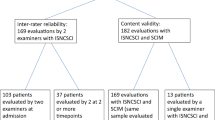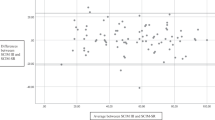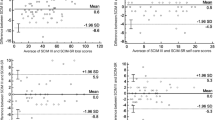Abstract
Study design:
This is a multicenter, prospective study.
Objectives:
The objective of this study was to assess the validity and reliability of the Turkish version of Spinal Cord Independence Measure-III (SCIM-III).
Setting:
This study was conducted in rehabilitation centers of three hospitals in Turkey.
Methods:
Two-hundred and four (n=204) consecutive patients with spinal cord injury (SCI) were included in the study. Each patient was examined by two physicians. Neurologic impairment was measured according to the American Spinal Injury Association (ASIA) Impairment Scale (AIS) 2000 revised criteria. Backward and forward translation of SCIM-III was performed by native speakers in both languages. To measure the validity of SCIM-III, the scores were compared with patients’ AIS grades, total motor scores and the Health Survey Short Form-36 (SF-36) subscale scores. SCIM-III was analyzed for test–retest reliability by the same rater on 49 patients during the follow-up evaluations.
Results:
Total agreement values between raters changed between 75.9 and 100%. Kappa values were all above 0.6, and they were statistically significant. The Pearson's correlation values between the raters were very high and statistically significant. The Cronbach’s α-values for the two consecutive raters were 0.865 and 0.896. Test–retest reliability was assessed by paired samples t-test, and no significant difference was observed. SCIM-III and SF-36 physical (r=0.339, P<0.005) and general health scores (r=0.200, P<0.005) showed correlation. All subscales of the SCIM-III, with the exception of self-care, had significant differences in comparison with the AIS grades. SCIM-III total and total motor scores showed correlation (r=0.585, P<0.001).
Conclusion:
The Turkish version of SCIM-III was found to be valid and reliable.
Similar content being viewed by others
Log in or create a free account to read this content
Gain free access to this article, as well as selected content from this journal and more on nature.com
or
References
Catz A, Itzkovich M, Agranov E, Ring H, Tamir A . SCIM–spinal cord independence measure: a new disability scale for patients with spinal cord lesions. Spinal Cord 1997; 35: 850–856.
Anderson K, Aito S, Atkins M, Biering-Sørensen F, Charlifue S, Curt A et al. From the 2006 NIDRR SCI measures meeting functional recovery measures for spinal cord injury: an evidence-based review for clinical practice and research. J Spinal Cord Med 2008; 31: 133–144.
Anderson KD, Acuff ME, Arp BG, Backus D, Chun S, Fisher K et al. United States (US) multi-center study to assess the validity and reliability of the Spinal Cord Independence Measure (SCIM III). Spinal Cord 2011; 49: 880–885.
Catz A, Itzkovich M, Tesio L, Biering-Sorensen F, Weeks C, Laramee MT et al. A multi-center international study on the Spinal Cord Independence Measure, version III: Rasch psychometric validation. Spinal Cord 2007; 45: 275–291.
Invernizzi M, Carda S, Milani P, Mattana F, Fletzer D, Iolascon G et al. Development and validation of the Italian version of the Spinal Cord Independence Measure III. Disabil Rehabil 2010; 32: 1194–1203.
Glass CA, Tesio L, Itzkovich M, Soni BM, Silva P, Mecci M et al. Spinal Cord Independence Measure, Version III: applicability to the UK spinal cord injured population. J Rehabil Med 2009; 41: 723–728.
Kesiktas N, Paker N, Bugdayci D, Sencan S, Karan A, Muslumanoglu L . Turkish adaptation of Spinal Cord Independence Measure-version III. Int J Rehabil Res 2012; 35: 88–91.
Zarco-Periñan MJ, Barrera-Chacón MJ, García-Obrero I, Mendez-Ferrer JB, Alarcon LE, Echevarria-Ruiz de Vargas C . Development of the Spanish version of the Spinal Cord Independence Measure version III: cross-cultural adaptation and reliability and validity study. Disabil Rehabil 2014; 36: 1644–1651.
Guillemin F, Bombardier C, Beaton B . Cross-cultural adaptation of health-related quality of life measures: literature review and proposed guidelines. J Clin Epidemiol 1993; 46: 1417–1432.
American Spinal Injury Association/International Medical Society of Paraplegia International Standards for Neurologic and Functional Classification of Spinal Cord Injury, Revised 2000. ASIA: Chicago, IL, USA. 2002.
Burns AS, Marino RJ, Flanders AE, Flett H . Clinical diagnosis and prognosis following spinal cord injury. Handb Clin Neurol 2012; 109: 47–62.
Itzkovich M, Gelernter I, Biering-Sorensen F, Weeks C, Laramee MT, Craven BC et al. The Spinal Cord Independence Measure (SCIM) version III: reliability and validity in a multi-center international study. Disabil Rehabil 2007; 29: 1926–1933.
Catz A, Itzkovich M, Steinberg F, Philo O, Ring H, Ronen J et al. The Catz-Itzkovich SCIM: a revised version of the Spinal Cord Independence Measure. Disabil Rehabil 2001; 23: 263–268.
Itzkovich M, Tripolski M, Zeilig G, Ring H, Rosentul N, Ronen J et al. Rasch analysis of the Catz-Itzkovich spinal cord independence measure. Spinal Cord 2002; 40: 396–407.
Fekete C, Eriks-Hoogland I, Baumberger M, Catz A, Itzkovich M, Lüthi H et al. Development and validation of a self-report version of the Spinal Cord Independence Measure (SCIM III). Spinal Cord 2013; 51: 40–47.
How to Score the SF-36 Short Form Health Survey International Resource Center Health Care Assessment. The Health Institute: Boston, MA, USA. 1994.
McHorney CA, Ware JE, Lu JF, Sherbourne CD . The MOS 36-item Short Form Health Survey (SF-36): III. Tests of data quality, scaling assumptions and reliability across diverse patient groups. Med Care 1994; 32: 40–66.
Forcheimer M, McAweeney M, Tate DG . Use of the SF-36 among persons with spinal cord injury. Am J Phys Med Rehabil 2004; 83: 390–395.
Demirsoy C . The MOS-SF-36 Health Survey: A Validation Study with a Turkish Sample. Unpublished Master’s Thesis. University of Bosphorus: Istanbul, Turkey. 1999.
Unalan H, Gencosmanoglu B, Akgun K, Karamehmetoglu S, Tuna H, Ones K et al. Quality of life of primary caregivers of spinal cord injury survivors living in the community: controlled study with short form-36 questionnaire. Spinal Cord 2001; 39: 318–322.
Lucke KT, Coccia H, Goode JS, Lucke JF . Quality of life in spinal cord injured individuals and their caregivers during the initial 6 months following rehabilitation. Qual Life Res 2004; 13: 97–110.
Hays RD, Hahn H, Marshall G . Use of the SF-36 and other health-related quality of life measures to assess persons with disabilities. Arch Phys Med Rehabil 2002; 83: S4–S9.
Rudhe C, van Hedel HJ . Upper extremity function in persons with tetraplegia: relationships between strength, capacity, and the spinal cord independence measure. Neurorehabil Neural Repair 2009; 23: 413–421.
Catz A, Itzkovich M . Spinal Cord Independence Measure: comprehensive ability rating scale for the spinal cord lesion patient. J Rehabil Res Dev 2007; 44: 65–68.
Catz A, Itzkovich M, Steinberg F, Philo O, Ring H, Ronen J et al. Disability assessment by a single rater or a team: a comparative study with the Catz-Itzkovich Spinal Cord Independence Measure. J Rehabil Med 2002; 34: 226–230.
Itzkovich M, Tamir A, Philo O, Steinberg F, Ronen J, Spasser R et al. Reliability of the Catz-Itzkovich Spinal Cord Independence Measure assessment by interview and comparison with observation. Am J Phys Med Rehabil 2003; 82: 267–272.
Acknowledgements
We thank Ramazan Bas who is the president of the Spinal Cord Paralytics Association of Turkey, and all its members.
Author information
Authors and Affiliations
Corresponding author
Ethics declarations
Competing interests
The authors declare no conflict of interest.
Rights and permissions
About this article
Cite this article
Unalan, H., Misirlioglu, T., Erhan, B. et al. Validity and reliability study of the Turkish version of Spinal Cord Independence Measure-III. Spinal Cord 53, 455–460 (2015). https://doi.org/10.1038/sc.2014.249
Received:
Revised:
Accepted:
Published:
Issue date:
DOI: https://doi.org/10.1038/sc.2014.249
This article is cited by
-
Cross-cultural adaptation and psychometric testing of the Thai version of the Spinal Cord Independence Measure III—Self Report
Spinal Cord (2021)
-
Development of Persian version of the Spinal Cord Independence Measure III assessed by interview: a psychometric study
Spinal Cord (2018)
-
Despite limitations in content range, the SCIM-III is reproducible and a valid indicator of physical function in youths with spinal cord injury and dysfunction
Spinal Cord (2018)
-
Do spinal cord-injured individuals with stronger sense of coherence use different psychological defense styles?
Spinal Cord (2016)



